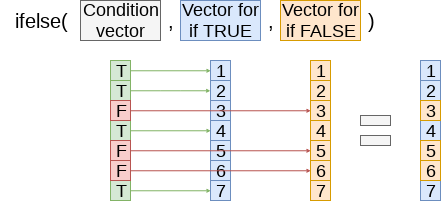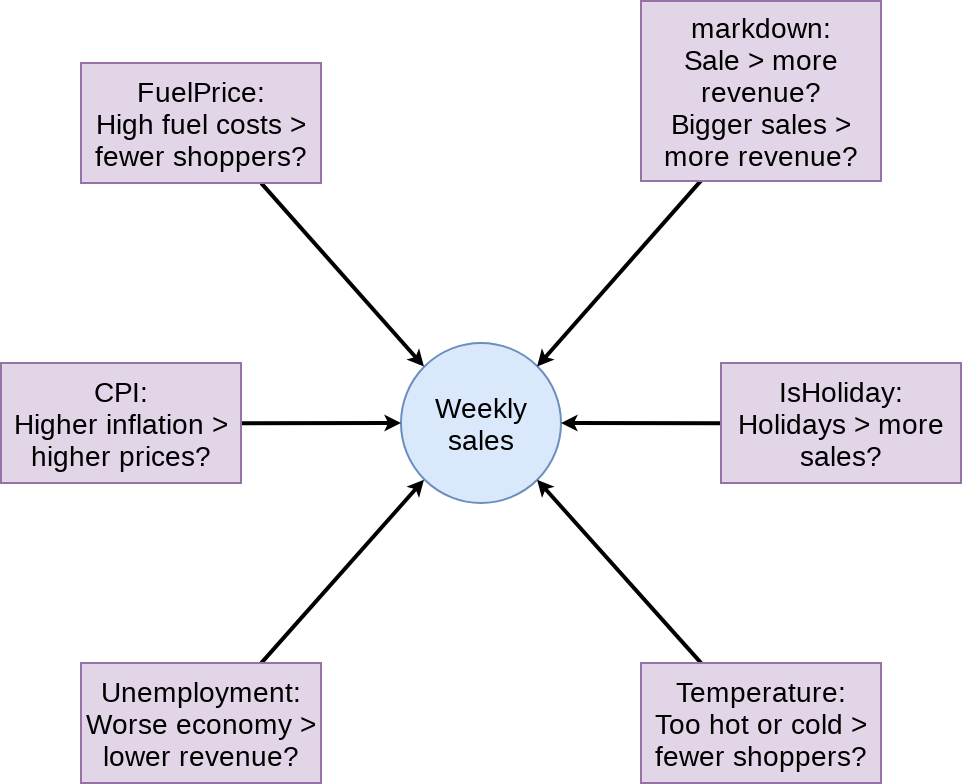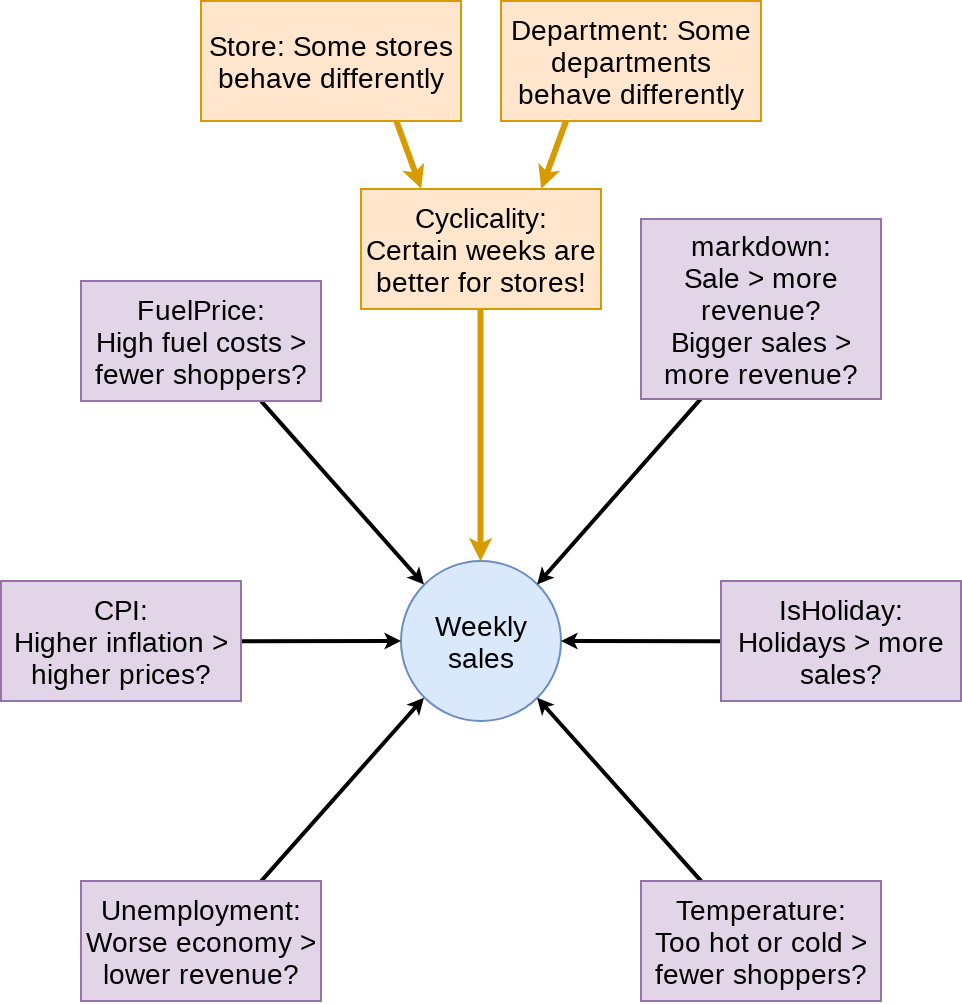ACCT 420: Project Example
Project Example
Dr. Richard M. Crowley
rcrowley@smu.edu.sg
http://rmc.link/
Weekly revenue prediction at Walmart
The question
How can we predict weekly departmental revenue for Walmart, leveraging our knowledge of Walmart, its business, and some limited historical information?
- Predict weekly for 115,064 (Store, Department, Week) tuples
- From 2012-11-02 to 2013-07-26
- Using [incomplete] weekly revenue data from 2010-02-015 to 2012-10-26
- By department (some weeks missing for some departments)
More specifically…
- Consider time dimensions
- What matters:
- Time of the year?
- Holidays?
- Do different stores or departments behave differently?
- What matters:
- Wrinkles:
- Walmart won’t give us testing data
- But they’ll tell us how well the algorithm performs
- We can’t use past week sales for prediction because we won’t have it for most of the prediction…
- Walmart won’t give us testing data
The data
- Revenue by week for each department of each of 45 stores
- Department is just a number between 1 and 99
- We don’t know what these numbers mean
- Date of that week
- If the week is considered a holiday for sales purposes
- Super Bowl, Labor Day, Black Friday, Christmas
- Department is just a number between 1 and 99
- Store data:
- Which store the data is for, 1 to 45
- Store type (A, B, or C)
- We don’t know what these letters mean
- Store size
- Other data, by week and location:
- Temperature, gas price, sales (by department), CPI, Unemployment rate, Holidays
Walmart’s evaluation metric
- Walmart uses MAE (mean absolute error), but with a twist:
- They care more about holidays, so any error on holidays has 5 times the penalty
- They call this WMAE, for weighted mean absolute error
\[ WMAE = \frac{1}{\sum w_i} \sum_{i=1}^{n} w_i \left|y_i-\hat{y}_i\right| \]
- \(n\) is the number of test data points
- \(\hat{y}_i\) is your prediction
- \(y_i\) is the actual sales
- \(w_i\) is 5 on holidays and 1 otherwise
Before we get started…
- The data isn’t very clean:
- Markdowns are given by 5 separate variables instead of 1
- Date is text format instead of a date
- CPI and unemployment data are missing in around a third of the testing data
- There are some (week, store, department) groups missing from our training data!
We’ll have to fix these
Also…
- Some features to add:
- Year
- Week
- A unique ID for tracking (week, firm, department) tuples
- The ID Walmart requests we use for submissions
- Average sales by (store, department)
- Average sales by (week, store, department)
Load data and packages
library(tidyverse) # we'll extensively use dplyr here
library(lubridate) # Great for simple date functions
library(broom)
weekly <- read.csv("../../Data/WMT_train.csv", stringsAsFactors=FALSE)
weekly.test <- read.csv("../../Data/WMT_test.csv", stringsAsFactors=FALSE)
weekly.features <- read.csv("../../Data/WMT_features.csv", stringsAsFactors=FALSE)
weekly.stores <- read.csv("../../Data/WMT_stores.csv", stringsAsFactors=FALSE)weeklyis our training dataweekly.testis our testing data – noWeekly_Salescolumnweekly.featuresis general information about (week, store) pairs- Temperature, pricing, etc.
weekly.storesis general information about each store
Cleaning
preprocess_data <- function(df) {
# Merge the data together (Pulled from outside of function -- "scoping")
df <- inner_join(df, weekly.stores)
df <- inner_join(df, weekly.features[,1:11])
# Compress the weird markdown information to 1 variable
df$markdown <- 0
df[!is.na(df$MarkDown1),]$markdown <- df[!is.na(df$MarkDown1),]$MarkDown1
df[!is.na(df$MarkDown2),]$markdown <- df[!is.na(df$MarkDown2),]$MarkDown2
df[!is.na(df$MarkDown3),]$markdown <- df[!is.na(df$MarkDown3),]$MarkDown3
df[!is.na(df$MarkDown4),]$markdown <- df[!is.na(df$MarkDown4),]$MarkDown4
df[!is.na(df$MarkDown5),]$markdown <- df[!is.na(df$MarkDown5),]$MarkDown5
# Fix dates and add useful time variables
df$date <- as.Date(df$Date)
df$week <- week(df$date)
df$year <- year(df$date)
df
}Merge data, fix
markdown, build time data
What this looks like
| Store | date | markdown | MarkDown3 | MarkDown4 | MarkDown5 | |
|---|---|---|---|---|---|---|
| 91 | 1 | 2011-10-28 | 0.00 | NA | NA | NA |
| 92 | 1 | 2011-11-04 | 0.00 | NA | NA | NA |
| 93 | 1 | 2011-11-11 | 6551.42 | 215.07 | 2406.62 | 6551.42 |
| 94 | 1 | 2011-11-18 | 5988.57 | 51.98 | 427.39 | 5988.57 |
| date | week | year |
|---|---|---|
| 2010-02-05 | 6 | 2010 |
| 2010-02-12 | 7 | 2010 |
Cleaning: Missing CPI and Unemployment
# Fill in missing CPI and Unemployment data
df_test <- df_test %>%
group_by(Store, year) %>%
mutate(CPI=ifelse(is.na(CPI), mean(CPI,na.rm=T), CPI),
Unemployment=ifelse(is.na(Unemployment),
mean(Unemployment,na.rm=T),
Unemployment)) %>%
ungroup()
Apply the (year, Store)’s CPI and Unemployment to missing data
Cleaning: Adding IDs
- Build a unique ID
- Since Store, week, and department are all 2 digits, make a 6 digit number with 2 digits for each
sswwdd
- Since Store, week, and department are all 2 digits, make a 6 digit number with 2 digits for each
- Build Walmart’s requested ID for submissions
ss_dd_YYYY-MM-DD
# Unique IDs in the data
df$id <- df$Store *10000 + df$week * 100 + df$Dept
df_test$id <- df_test$Store *10000 + df_test$week * 100 + df_test$Dept
# Unique ID and factor building
#swd <- c(df$id, df_test$id) # Pool all IDs
#swd <- unique(swd) # Only keep unique elements
#swd <- data.frame(swd=swd) # Make a data frame
#swd$swd <- factor(swd$id) # Extract factors for using later
# Add unique factors to data -- ensures same factors for both data sets
#df <- left_join(df,swd)
#df_test <- left_join(df_test,swd)What the IDs look like
| Store | week | Dept | id | Id |
|---|---|---|---|---|
| 8 | 27 | 33 | 82733 | 8_33_2013-07-05 |
| 15 | 46 | 91 | 154691 | 15_91_2012-11-16 |
| 23 | 52 | 25 | 235225 | 23_25_2012-12-28 |
Add in (store, department) average sales
# Calculate average by store-dept and distribute to df_test
df <- df %>%
group_by(Store, Dept) %>%
mutate(store_avg=mean(Weekly_Sales, rm.na=T)) %>%
ungroup()
df_sa <- df %>%
group_by(Store, Dept) %>%
slice(1) %>%
select(Store, Dept, store_avg) %>%
ungroup()
df_test <- left_join(df_test, df_sa)## Joining, by = c("Store", "Dept")Add in (week, store, dept) average sales
# Calculate mean by week-store-dept and distribute to df_test
df <- df %>%
group_by(Store, Dept, week) %>%
mutate(naive_mean=mean(Weekly_Sales, rm.na=T)) %>%
ungroup()
df_wm <- df %>%
group_by(Store, Dept, week) %>%
slice(1) %>%
ungroup() %>%
select(Store, Dept, week, naive_mean)
df_test <- df_test %>% arrange(Store, Dept, week)
df_test <- left_join(df_test, df_wm)## Joining, by = c("Store", "Dept", "week")ISSUE: New (week, store, dept) groups
- This is in our testing data!
- So we’ll need to predict out groups we haven’t observed at all
##
## FALSE TRUE
## 113827 1237Cleaning is done
- Data is in order
- No missing values where data is needed
- Needed values created
df %>%
group_by(week, Store) %>%
mutate(sales=mean(Weekly_Sales)) %>%
slice(1) %>%
ungroup() %>%
ggplot(aes(y=sales, x=week, color=factor(Store))) +
geom_line() + xlab("Week") + ylab("Sales for Store (dept average)") +
theme(legend.position="none")
Tackling the problem
First try
- Ideal: Use last week to predict next week!

No data for testing…
- First instinct: try to use a linear regression to solve this

We have this
What to put in the model?

First model
mod1 <- lm(Weekly_mult ~ factor(IsHoliday) + factor(markdown>0) +
markdown + Temperature +
Fuel_Price + CPI + Unemployment,
data=df)
tidy(mod1)## # A tibble: 8 x 5
## term estimate std.error statistic p.value
## <chr> <dbl> <dbl> <dbl> <dbl>
## 1 (Intercept) 1.24 0.0370 33.5 4.10e-245
## 2 factor(IsHoliday)TRUE 0.0868 0.0124 6.99 2.67e- 12
## 3 factor(markdown > 0)TRUE 0.0531 0.00885 6.00 2.00e- 9
## 4 markdown 0.000000741 0.000000875 0.847 3.97e- 1
## 5 Temperature -0.000763 0.000181 -4.23 2.38e- 5
## 6 Fuel_Price -0.0706 0.00823 -8.58 9.90e- 18
## 7 CPI -0.0000837 0.0000887 -0.944 3.45e- 1
## 8 Unemployment 0.00410 0.00182 2.25 2.45e- 2## # A tibble: 1 x 12
## r.squared adj.r.squared sigma statistic p.value df logLik AIC BIC
## <dbl> <dbl> <dbl> <dbl> <dbl> <dbl> <dbl> <dbl> <dbl>
## 1 0.000481 0.000464 2.03 29.0 2.96e-40 7 -895684. 1.79e6 1.79e6
## # ... with 3 more variables: deviance <dbl>, df.residual <int>, nobs <int>Prep submission and check in sample WMAE
# Out of sample result
df_test$Weekly_mult <- predict(mod1, df_test)
df_test$Weekly_Sales <- df_test$Weekly_mult * df_test$store_avg
# Required to submit a csv of Id and Weekly_Sales
write.csv(df_test[,c("Id","Weekly_Sales")],
"WMT_linear.csv",
row.names=FALSE)
# track
df_test$WS_linear <- df_test$Weekly_Sales
# Check in sample WMAE
df$WS_linear <- predict(mod1, df) * df$store_avg
w <- wmae(actual=df$Weekly_Sales, predicted=df$WS_linear, holidays=df$IsHoliday)
names(w) <- "Linear"
wmaes <- c(w)
wmaes## Linear
## 3073.57Visualizing in sample WMAE
wmae_obs <- function(actual, predicted, holidays) {
abs(actual-predicted)*(holidays*5+1) / (length(actual) + 4*sum(holidays))
}
df$wmaes <- wmae_obs(actual=df$Weekly_Sales, predicted=df$WS_linear,
holidays=df$IsHoliday)
ggplot(data=df, aes(y=wmaes, x=week, color=factor(IsHoliday))) +
geom_jitter(width=0.25) + xlab("Week") + ylab("WMAE")
Back to the drawing board…

Second model: Including week
mod2 <- lm(Weekly_mult ~ factor(week) + factor(IsHoliday) + factor(markdown>0) +
markdown + Temperature +
Fuel_Price + CPI + Unemployment,
data=df)
tidy(mod2)## # A tibble: 60 x 5
## term estimate std.error statistic p.value
## <chr> <dbl> <dbl> <dbl> <dbl>
## 1 (Intercept) 1.00 0.0452 22.1 3.11e-108
## 2 factor(week)2 -0.0648 0.0372 -1.74 8.19e- 2
## 3 factor(week)3 -0.169 0.0373 -4.54 5.75e- 6
## 4 factor(week)4 -0.0716 0.0373 -1.92 5.47e- 2
## 5 factor(week)5 0.0544 0.0372 1.46 1.44e- 1
## 6 factor(week)6 0.161 0.0361 4.45 8.79e- 6
## 7 factor(week)7 0.265 0.0345 7.67 1.72e- 14
## 8 factor(week)8 0.109 0.0340 3.21 1.32e- 3
## 9 factor(week)9 0.0823 0.0340 2.42 1.55e- 2
## 10 factor(week)10 0.101 0.0341 2.96 3.04e- 3
## # ... with 50 more rows## # A tibble: 1 x 12
## r.squared adj.r.squared sigma statistic p.value df logLik AIC BIC
## <dbl> <dbl> <dbl> <dbl> <dbl> <dbl> <dbl> <dbl> <dbl>
## 1 0.00501 0.00487 2.02 35.9 0 59 -894728. 1.79e6 1.79e6
## # ... with 3 more variables: deviance <dbl>, df.residual <int>, nobs <int>Prep submission and check in sample WMAE
# Out of sample result
df_test$Weekly_mult <- predict(mod2, df_test)
df_test$Weekly_Sales <- df_test$Weekly_mult * df_test$store_avg
# Required to submit a csv of Id and Weekly_Sales
write.csv(df_test[,c("Id","Weekly_Sales")],
"WMT_linear2.csv",
row.names=FALSE)
# track
df_test$WS_linear2 <- df_test$Weekly_Sales
# Check in sample WMAE
df$WS_linear2 <- predict(mod2, df) * df$store_avg
w <- wmae(actual=df$Weekly_Sales, predicted=df$WS_linear2, holidays=df$IsHoliday)
names(w) <- "Linear 2"
wmaes <- c(wmaes, w)
wmaes## Linear Linear 2
## 3073.570 3230.643Visualizing in sample WMAE
df$wmaes <- wmae_obs(actual=df$Weekly_Sales, predicted=df$WS_linear2,
holidays=df$IsHoliday)
ggplot(data=df, aes(y=wmaes,
x=week,
color=factor(IsHoliday))) +
geom_jitter(width=0.25) + xlab("Week") + ylab("WMAE")
Visualizing in sample WMAE by Store
ggplot(data=df, aes(y=wmae_obs(actual=Weekly_Sales, predicted=WS_linear2,
holidays=IsHoliday),
x=week,
color=factor(Store))) +
geom_jitter(width=0.25) + xlab("Week") + ylab("WMAE") +
theme(legend.position="none")
Visualizing in sample WMAE by Dept
ggplot(data=df, aes(y=wmae_obs(actual=Weekly_Sales, predicted=WS_linear2,
holidays=IsHoliday),
x=week,
color=factor(Dept))) +
geom_jitter(width=0.25) + xlab("Week") + ylab("WMAE") +
theme(legend.position="none")
Back to the drawing board…

Third model: Including week x Store x Dept
mod3 <- lm(Weekly_mult ~ factor(week):factor(Store):factor(Dept) + factor(IsHoliday) + factor(markdown>0) +
markdown + Temperature +
Fuel_Price + CPI + Unemployment,
data=df)
## Error: cannot allocate vector of size 606.8Gb…
Third model: Including week x Store x Dept
library(fixest)
mod3 <- feols(Weekly_mult ~ markdown +
Temperature +
Fuel_Price +
CPI +
Unemployment | id, data=df)
tidy(mod3)## # A tibble: 5 x 5
## term estimate std.error statistic p.value
## <chr> <dbl> <dbl> <dbl> <dbl>
## 1 markdown -0.00000139 0.000000295 -4.73 2.24e- 6
## 2 Temperature 0.00135 0.000243 5.55 2.83e- 8
## 3 Fuel_Price -0.0637 0.00905 -7.04 1.92e-12
## 4 CPI 0.00150 0.000800 1.87 6.13e- 2
## 5 Unemployment -0.0303 0.00386 -7.85 4.14e-15## # A tibble: 1 x 9
## r.squared adj.r.squared within.r.squared pseudo.r.squared sigma nobs AIC
## <dbl> <dbl> <dbl> <dbl> <dbl> <int> <dbl>
## 1 0.823 0.712 0.000540 NA 1.09 421564 1.39e6
## # ... with 2 more variables: BIC <dbl>, logLik <dbl>Prep submission and check in sample WMAE
# Out of sample result
df_test$Weekly_mult <- predict(mod3, df_test)
df_test$Weekly_Sales <- df_test$Weekly_mult * df_test$store_avg
# Replace NA values with store average
df_test <- df_test %>%
mutate(Weekly_Sales = ifelse(is.na(Weekly_Sales), naive_mean, Weekly_Sales))
# Required to submit a csv of Id and Weekly_Sales
write.csv(df_test[,c("Id","Weekly_Sales")],
"WMT_FE.csv",
row.names=FALSE)
# track
df_test$WS_FE <- df_test$Weekly_Sales
# Check in sample WMAE
df$WS_FE <- predict(mod3, df) * df$store_avg
w <- wmae(actual=df$Weekly_Sales, predicted=df$WS_FE, holidays=df$IsHoliday)
names(w) <- "FE"
wmaes <- c(wmaes, w)
wmaes## Linear Linear 2 FE
## 3073.570 3230.643 1552.190Visualizing in sample WMAE
df$wmaes <- wmae_obs(actual=df$Weekly_Sales, predicted=df$WS_FE,
holidays=df$IsHoliday)
ggplot(data=df, aes(y=wmaes,
x=week,
color=factor(IsHoliday))) +
geom_jitter(width=0.25) + xlab("Week") + ylab("WMAE")## Warning: Removed 6 rows containing missing values (geom_point).
Maybe the data is part of the problem?
- What problems might there be for our testing sample?
- What is different from testing to training?
- Can we fix them?
- If so, how?
End Matter
This was a real problem!
- Walmart provided this data back in 2014 as part of a recruiting exercise
- This is what the group project will be like
- 4 to 5 group members tackling a real life data problem
- You will have training data but testing data will be withheld
- Submit on Kaggle
Project deliverables
- Kaggle submission
- Your code for your submission, walking through what you did
- A 15 minute presentation on the last day of class describing:
- Your approach
- A report discussing
- Main points and findings
- Exploratory analysis of the data used
- Your model development, selection, implementation, evaluation, and refinement
- A conclusion on how well your group did and what you learned in the process